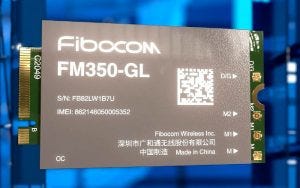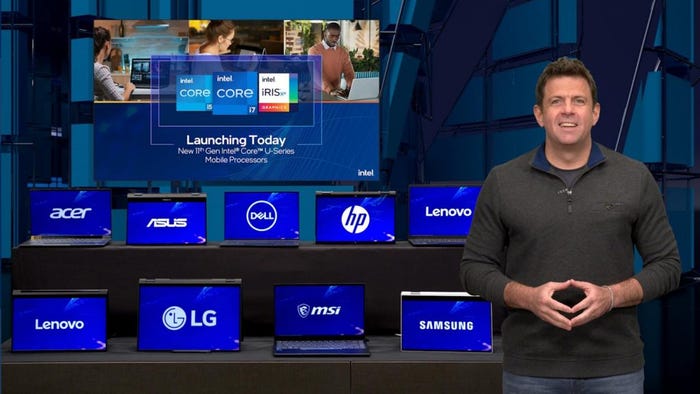Intel Launches Its First 5G M.2 Modem for Laptops, Sees Strong PC DemandIntel Launches Its First 5G M.2 Modem for Laptops, Sees Strong PC Demand
But supply chain shortages could take years to fix.
June 1, 2021

COMPUTEX 2021 — Acer, Asus and HP are the first PC OEMs poised to deliver laptops with Intel’s first 5G M.2 modem. Expect the laptops with Intel’s 5G Solution 5000, debuting Monday at the virtual Computex conference, to appear later this year.
Laptops designed with M.2 interfaces have become common, as it is the standard form factor for internal SSD drives. By creating M.2 modems, it will offer OEMs a standard and more reliable way to offer always connected, 5G laptops. It also means channel partners will have access to a wider variety of 5G laptops.
 Intel’s launch comes two weeks after Qualcomm released a 10Gbps, 5G M.2 reference design for its Snapdragon X65 and X62 processors. Unlike the Intel 5G Solution 5000, Qualcomm’s reference design also targets mobile broadband devices, on-premises communications equipment and gaming products. Qualcomm’s M.2 reference design supports 5G sub-6 and extended-range mmWave frequencies. Intel designed its 5G Solution 5000 for sub 6GHz-based 5G networks.
Intel’s launch comes two weeks after Qualcomm released a 10Gbps, 5G M.2 reference design for its Snapdragon X65 and X62 processors. Unlike the Intel 5G Solution 5000, Qualcomm’s reference design also targets mobile broadband devices, on-premises communications equipment and gaming products. Qualcomm’s M.2 reference design supports 5G sub-6 and extended-range mmWave frequencies. Intel designed its 5G Solution 5000 for sub 6GHz-based 5G networks.
“Qualcomm’s modem technology is advanced – and it has complete RF systems on offer – but its design wins are mainly with fixed wireless providers, not laptops,” said industry analyst Avi Greengart of Techsponential.
Besides the 5G laptops from Acer, Asus and HP planned for this year, 29 OEMs will deliver PCs equipped with Intel’s 5G Solution 5000, Steve Long, Intel’s corporate VP for sales, marketing and communications said during the keynote session.
Intel’s 5G M.2 effort has been in the works since late 2019 when it announced it had partnered with MediaTek. The partnership called for MediaTek to help design, certify and support 5G modems optimized for Intel-based PCs. Intel and MediaTek partnered with Fibocom to provide manufacturing of its, sales and distribution of its 5G M.2 modems.
“Laptops are a device category where 5G’s faster speeds and lower latency provides obvious and immediate benefit; I can’t wait to get hands on with one,” said Greengart said.
Power Boost for 11th Gen U-Series
Intel also said it new U-Series 11th Gen Core processors with its Iris Xe graphics will roll out later this year. Intel’s Long said the new i7-1195G7 and i5-115G7 will include the first 5Ghz processor in a U-Series processor. Select new designs will support higher speed Wi-Fi 6E (Gig+). Intel said the new processors will have lower latency.

Intel’s Steve Long at Computex 2021
“There are going to be over 60 designs from OEMs based on these two skews available by holiday with designs from Acer, Asus, Lenovo and MSI landing on shelves this summer, some of them selling this week,” Long said. In all, that will raise the total of 11th Gen Core U-Series designs up to 250, according to Long.
Rising PC Demand
Intel is priming its channels for increased demand for PCs, which have risen since the outset of the pandemic last year. Late last week, HP reported revenue of $10.6 billion from its personal systems group for its second fiscal quarter. That was a 27% jump.
During the same calendar period, Dell last week also reported strong PC growth, with revenues of $13.3 billion up 20%.
Intel officials anticipate demand for PCs will continue to rise.
“The demand is unprecedented,” Long said. “This year is shaping up to be the largest PC market ever, with fundamental demand drivers that are here to stay.”
No Quick Fix for Supply Chain Shortages
Supply chain shortages continue to put a damper on strong demand for PCs and other hardware-based solutions. Intel CEO Pat Gelsinger, appearing during the keynote session, reiterated he sees no near-term end to the supply chain shortages.
“We have been working diligently with our partners, including so many of you, to address constraints and increase output to meet demand,” Gelsinger said. “For example, we’ve doubled our internal wafer capacity in the past four years. But while the industry has taken steps to address near term constraints, it could still take a couple of years for the ecosystem to address shortages of foundry capacity, substrates and components.”
Want to contact the author directly about this story? Have ideas for a follow-up article? Email Jeffrey Schwartz or connect with him on LinkedIn. |
Read more about:
VARs/SIsAbout the Author
You May Also Like


